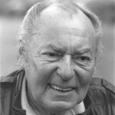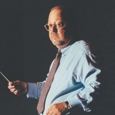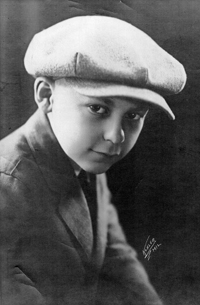 Woody Herman was one of the giants and leaders in the Big Band era. He started playing clarinet and saxophone in local Milwaukee bands while still in high school. He eventually landed a job with the famous Isham Jones, and shortly after took over the band when Jones retired. Woody was known as a suave gentleman by his peers and the road father and coach to his musicians.
Woody Herman was one of the giants and leaders in the Big Band era. He started playing clarinet and saxophone in local Milwaukee bands while still in high school. He eventually landed a job with the famous Isham Jones, and shortly after took over the band when Jones retired. Woody was known as a suave gentleman by his peers and the road father and coach to his musicians.
Woodrow Charles Thomas Herman was born on the Northeast side of Milwaukee on May 16, 1913. He was an only child, and his father had a great record collection which he sang and taught to young Woody. As far back as Woody could remember, his father had always wanted to be in show business but spent his entire life working as a shoemaker for in Milwaukee. Shortly after Woody could walk, his father began to coach him in dancing.
When Woody was eight, his father thought it was time for him to launch his show business career. He took him to an audition for a kiddie revue run by an older woman who had been an actress. He won the part with about six or seven other kids and his career began.
They travelled to Northern Wisconsin and Upper Michigan, always staying within a few hundred miles of Milwaukee. These tours took place during the summer months. About this time, his father encouraged Woody to learn an instrument. He tried piano and violin with little success, so with the money he earned during the summer he bought an alto saxophone and began taking lessons. His teacher then told him he should also begin on clarinet because it was more difficult than saxophone. Dance lessons continued. Sports were also very important to Woody.
Woody toured with the kiddie revue for a few more years but when he returned to school in the fall, school administrators and juvenile court gave his parents a great deal of trouble for letting him work in show business. At that time, young Woody had heard of a school where the administrators and teachers were more interested in the individual students. So while both parents were at work, ten-year-old Woody managed to transfer to St. John Cathedral School in downtown Milwaukee.
After he left the kiddie revue, he began playing one-nighters as a singer, dancer, and saxophone player in Vaudeville shows in and around Milwaukee and Chicago, booked as “The Boy Wonder.” It was at this time that he changed the spelling of his name from Herrmann to Herman. He thought this spelling would take less room and look better in lights. The more he worked in vaudeville, the more he became interested in jazz. He began taking lessons from a jazz-oriented music teacher who taught and wrote out jazz riffs for him. While a freshman at Cathedral High School he decided he wanted to be a jazz player.
During his freshman year he earned his first steady job in a band with some older guys playing in and around Milwaukee, usually until three or four in the morning. One of the guys would pick him up and take him home. Woody had boundless energy and always reached school on time, but his occasional dozing in class did not go over well with the nun who was his teacher. As a result he often saw the inside of the principal’s office. Enter Sister Fabian Reilly.
During his second semester, she was his science teacher and believed that being a musician was a good thing. She became a guardian angel for him, keeping him in school, for which Woody was always indebted to her. He stayed in touch with Sr. Fabian throughout her life and always tried to see her when he was in town. He also brought his band to Milwaukee annually to play benefit concerts for Cathedral High School.
His love for jazz only increased. His friend Erwin Sherman would come over after school and crank up the old Victrola and listen to the great jazz players of the day like Jimmy Dorsey, Pee Wee Erwin, and Glenn Miller, but the playing of Coleman Hawkins and Frankie Trumbauer really caught Woody’s ear. He worked diligently to learn their jazz riffs and solos. Woody played with Joey Lichter, a local Milwaukee band, through his high school years, and Sister Fabian saved him from being expelled from school. In the middle of his last semester in 1931, Tom Gerun, whose band was playing at the Schroeder Hotel in Milwaukee, offered him a job. He accepted and did not finish high school. His career as a jazz musician had begun.
On the Road as a Sideman
Woody met the Gerun Band in Chicago. As Woody’s jazz playing was influenced by Coleman Hawkins and Frankie Trumbauer, his singing was influenced by Russ Colombo, Lee Wiley, and songwriter Harold Arlen. While playing with the band in San Francisco he met a beautiful dancer with flaming red hair named Charlotte Neste, who later became his wife after a long distance romance.
After a time with the Gerun Orchestra, he worked with the orchestras of Harry Sosnick and Gus Arnheim before landing a job with the popular Isham Jones Orchestra. Jones was also extremely famous for his compositions that included, I’ll See You in My Dreams, It Had to Be You, and On the Alamo. These songs and many others made Jones quite wealthy, leading him to retire. When Jones did retire, Woody and a few members formed a cooperative band with each member as a stockholder. They voted for Woody as the leader. This was 1936 and Woody was directing his first band, The Band That Plays the Blues. He also married Charlotte that same year.
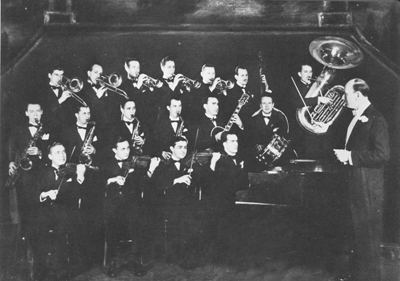
Woody Herman in the Isham Jones band, circa 1934-35, at the left end of the saxophone section. It was in 1936 that Woods became the leader of this band upon Isham’s retirement.
The Leader
When this new cooperative band was formed, the members included fine arrangers and players like Joe Bishop, and Nick Harper, who Woody knew from Milwaukee. The band tried to live up to its name, because the players knew blues the best.
The band rehearsed for a few weeks, then opened at the Roseland Ballroom in Brooklyn on Election Night 1936 with less than ten arrangements in the book. The rest of the tunes they played were head charts, those made up by the band members on the job. One of those was a blues riff that eventually developed into Woodchopper’s Ball.
This gig lasted seven months, and during this time, Woody signed a management contract with General Artists Corporation, but nothing really came of it. In fact, when the engagement was over, GAC dropped them, telling Woody that they couldn’t really help book them. The band continued to stay true to the blues and recorded several sides for Decca Records, each having Blue in the title. Woody changed the theme of the band from Blue Prelude to Blue Flame shortly after playing a date at Milwaukee’s Schroeder Hotel. (Some say Woody picked Blue Flame as the title as a reference to the large flame atop the Gas Company building on East Wisconsin Avenue in downtown Milwaukee.)
The band thrived musically but struggled financially. In 1938 the band was playing in Boston. During his free time, bassist Walt Yoder went to a sports show and saw a number of woodsmen competing against the clock for prizes, hence the title Woodchopper’s Ball. Woody recorded Joe Bishop’s new hot arrangement of the tune for Decca in 1938 and over the years it sold over five million copies. At this time, the band could not get very far without some financial backing.
Herman was advised to contact the Schribmann brothers, Charles and Si. These men did not provide monetary support, but owned hotels and ballrooms where new bands could play. They could also arrange for air time and radio shows, which proved invaluable. The Schribmanns were honest and saved many bands, including those of Artie Shaw and Glenn Miller.
By the end of 1939, the band received some top bookings for good money. Woody began looking for a female vocalist and auditioned quite a few, including Dinah Shore, but settled on Mary Ann McCall. Billie Rogers, a female trumpet player and vocalist joined the band at this time.
In 1941 the band recorded Blues in the Night with Woody doing the vocals. It was the second big hit for the group. A second big event that year was the birth of his daughter, Ingrid, in September. With WWII starting, many musicians were entering the service, including some from the co-op band. Woody began to pick up their stock, making him the band,s sole owner. He also tried to enlist but was rejected.
By 1943, The Band That Plays the Blues about to disband. Herman was always impressed with Duke Ellington and his Orchestra, and he wanted to make changes to his next group. Woody moved to the west coast and hired new writers, including Dizzy Gillespie, to write for the band. During this turbulent time many young musicians who later on became very famous, passed through the band. Some were there for only a week. Even so, the band did very well, with recordings and appearances in movies with the Andrews Sisters and ice skating star Sonja Henie. The word was out that Herman was an excellent leader and employer.
1944-1946: The First Herd
On a summer night in Connecticut in 1944, jazz historian, expert and author George T. Simon heard this new Herman Band and said, “This band gave me one of the biggest thrills of my life.” The instrumentation still had five saxes (two altos, two tenors and one bari) but had four trumpets, three trombones, and five rhythm players (piano, bass, drums, guitar, and vibist Margie Hyams). He went on to name the band the Herman Herd in the September 1944 issue of Metronome. Woody’s band will now and forever be known as the Herd.
Woody loved this new band, not only for its musicality, but because it excited the audience. It had a spirit and enthusiasm, and as a result, the band starred on two radio series, the Old Gold program, and then the Wildroot Adventure series, The recordings continued to sell very well; Woody and the band were on top of the world.
Igor Stravinsky was a true fan of the band. When Woody suggested to Stravinsky that he write a piece for the band he agreed. After the piece was completed, the band had trouble learning it. Most of the musicians had no classical training and had learned new charts from each other. The rehearsals were just as difficult for Stravinsky, as he had to rewrite the concerto in 44 time because that was what the jazz musicians knew best. Despite these obstacles, the Ebony Concerto was performed at Carnegie Hall in March of 1946 to mixed reviews. The idea to blend classic and jazz music was a great one, and similar works were created in later years.
In August Woody purchased the home of Humphrey Bogart and Lauren Bacall in the Hollywood Hills. By the end of 1946 the band had won the Downbeat, Metronome, and Esquire polls as the leading big band, and several of the players won first place on their instruments in these same polls. Financially the band did extremely well, but Woody broke up the group in December of 1946 and returned to his wife and young daughter in California. He had saved money for them to live on, but unfortunately, he discovered that someone in his office had not paid the IRS some due taxes. Woody’s nest egg went to pay this debt, which meant he would have to go on the road again.
1947-1948: The Second Herd: The “Four Brothers” Band
When Woody came back after his short vacation, he wanted to do something new and exciting. By the middle of 1947, the big band business was declining. His decided to follow the bebop direction of Charlie Parker and Dizzy Gillespie. Jimmy Giuffre heard Herman might be organizing a new band again and suggested a novel saxophone section with three tenors and one bari.
The original sax section was Stan Getz, Zoot Sims, and Herbie Steward (later replaced by Al Cohn) on tenor saxes, and Serge Chaloff on baritone sax. This section of young stars was selected by Woody in his tradition of bringing fresh new and young talent to the band. Each of these players became stars in their own right later. This new band, according to many of its members, was the best. However there were drawbacks. People were not used to bebop, and many wanted to hear the old Herman standards or the pop tunes of the day. Woody admitted the band was an albatross, including some members who used drugs. By the end of 1949 Woody took an all-star group to Havana, Cuba for four weeks. Musically the group was fine, but the people were not familiar with Woody and his new music. Upon their return he disbanded again.
1950-1955: The Third Herd
Following this the Third Herd was born. In early October, 1951, Woody returned to Milwaukee at the request of his friend and mentor, Sister Fabian Reilly, to play for a fundraising event for the building of a new gymnasium at St. John’s Cathedral. The 1950s were a difficult time for big bands. In the fall of 1953, Woody and the band started playing high school and college jazz festivals and concerts.
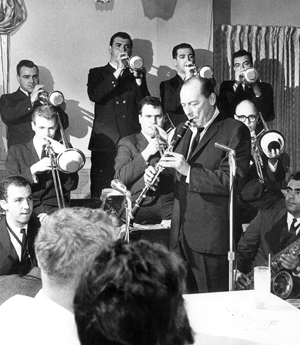 1956-1967: The Fourth Herd (The New Third Herd)
1956-1967: The Fourth Herd (The New Third Herd)
1960-1967: The Swinging Herd
The Herds continued to work playing one-nighters, recording, and facing the typical ups and downs of changing musical tastes. A highlight of early 1959 was a tour of the British Isles and participation in the 1959 Monterey Jazz Festival. During the early 1960s, the band was rediscovered by the younger generation. In 1960 Herman and the band performed at President John F. Kennedy’s Inaugural Ball. This was a hard charging Herman band composed of vibrant, young, exciting jazz players. Around this time, Woody learned of problems with the IRS. His manager and close friend, Abe Turchen, had not paid Herman’s taxes for several years, and he now owed the IRS more than a million dollars. It seems that Turchen secretly held back money from Woody and gambled it away. In 1968 Woody fired Turchen and hired Hermie Dresel. (right: Woody Herman and his band in Milwaukee at the Tunnel Inn, 1961.)
1968-1979: The Fusion Era
Woody, the consummate adventurous band leader, decided to once again change the attitude and complexion of the band. He added such electronic instruments as bass guitar and electric piano and a moderate rock beat but maintained the driving, hard charging horn section. The charts were written by hip, young arrangers. This band had a grooving jazz-rock rhythm section and a hard-swinging horn section. I thought this band was truly special; it seemed to thrill young and old fans alike.
A great event for Woody was his 40th Anniversary Concert at Carnegie Hall, a truly nostalgic event. The music ran the gamut from Woodchopper’s Ball to Fanfare for the Common Man. In 1971, Woody and the band started doing university and high school jazz concerts and clinics with the first of these held in May at Northern Illinois University. April 1974, he returned to Milwaukee and St. John Cathedral High School to start a music scholarship fund for high school students in the name of Sister Fabian Reilly
1980: Until the End
Woody kept working on and off forming new bands and small groups. He toured overseas and was constantly plagued by the IRS. In 1980, he and the
band performed at President Reagan’s Inaugural Ball. Woody celebrated his 50th Anniversary as a band leader on July 16, 1986 at the Hollywood Bowl with a huge concert. Two bands were present, one composed of Herman alums, the other the current Young Thundering Herd led by Woody. Woody began having health problems and passed away at home on October 27, 1987.
The Legacy
Woody Herman was one of the most beloved big band leaders of them all. He was a gentleman who sought out the best young players and gave them the opportunity to express themselves musically and vocally. He listened about who to hire as players and he let his writers be creative. He had a great sense of humor that everyone appreciated. He was loyal, to his wife and family, Sister Fabian Reilly and his school, the greater Milwaukee community, the Sherman Brothers, his musicians, and his friends. He knew how to get the best out of musicians. It was because of him that the great jazz stars of the 60s, 70s and 80s became known.
The legacy of Woody Herman lives on through the concerts and clinics he established in high schools and universities and in Milwaukee through the scholarship committee Woody created. Woody may be gone, but the Young Thundering Herd led by Frank Tiberi continues on, as does the Milwaukee scholarship committee with members Don Huenefeld, Jim Sewrey, Terry Treuden, and me. As Woody would say, “Keep on, keeping on.”
Bibliography
Clancy, William D. with Kenton, Audree Coke; Woody Herman Chronicles of the Herds; Schirmer Books, New York; 1995.
Corenthal, Michael G.; The Illustrated History of Wisconsin Music 1840-1990; MGC Publications, Milwaukee; 1991.
Kloss, Jerry; “A New Twist to the Old Story About a Star and His Friend”; The Milwaukee Journal Green Sheet, April 7, 1981.
Simon, George T.; The Big Bands; Macmillan Publishing Co. Inc.; New York; 1974.
Herman, Woody and Troup, Stuart; The Woodchopper’s Ball; Limelight Editions; New York; 1994.
Walker, Leo; The Big Band Almanac; Da Capo Press; Hollywood; 1989.
